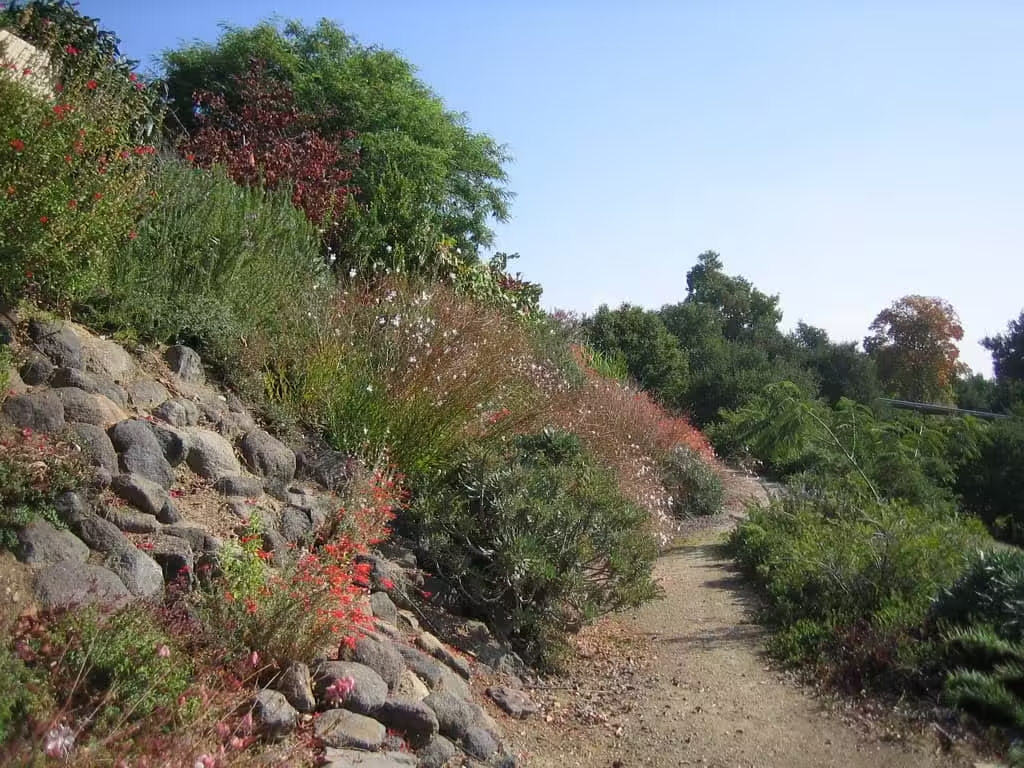
Imagine a lush, vibrant landscape thriving without a drop of municipal water. That’s the power of xeriscaping off-grid. In 2024, as climate change intensifies and more people seek self-sufficiency, this innovative approach to landscaping is revolutionizing how we think about outdoor spaces. Did you know that xeriscaping can reduce outdoor water use by up to 60%? Let’s dive into the world of water-wise, off-grid gardening and transform your piece of land into a sustainable oasis!
What is Xeriscaping and Why It’s Perfect for Off-Grid Living
Xeriscaping is essentially a landscaping approach that focuses mainly on water conservation but also has the added bonus of being both low maintenance and aesthetically pleasing. The term comes from the Greek word “xeros,” meaning dry, combined with “landscaping.” As the name describes, xeriscaping usually means replacing traditional garden landscapes with drought-tolerant native plants.
Principles of Xeriscaping
To truly understand xeriscaping, let’s break down its seven core principles:
- Thoughtful planning and design
- Soil improvement for better water retention
- Efficient irrigation systems
- Appropriate plant selection (focusing on native and drought-tolerant species)
- Practical turf areas (or alternatives to traditional lawns)
- Use of mulches to reduce evaporation
- Proper maintenance to preserve water efficiency
These principles work together to create a sustainable, water-wise landscape that’s perfect for off-grid properties.
Benefits of Xeriscaping for Off-Grid Homesteads
Xeriscaping offers numerous advantages for those living off the grid:
- Water Conservation: Reduces outdoor water use by up to 60%, which is crucial for self-sufficient living.
- Lower Maintenance: Requires less mowing, pruning, and overall care compared to traditional landscapes.
- Cost-Effective: Saves money on water bills and landscape upkeep in the long run.
- Eco-Friendly: Supports local ecosystems and reduces the need for harmful pesticides and fertilizers.
- Resilience: Withstands drought conditions and adapts to local climate challenges.
- Year-Round Beauty: Provides in all seasons with proper plant selection.
Environmental Impact of Xeriscaping
The positive environmental effects of xeriscaping extend beyond your property lines. By implementing these water-wise techniques, you’re contributing to:
- Reduced strain on local water supplies
- Decreased runoff and erosion
- Lower energy consumption (less water pumping and treatment)
- Improved air quality (fewer emissions from lawn equipment)
- Enhanced biodiversity by creating habitats for native species
Overcoming Misconceptions
Despite its many benefits, xeriscaping sometimes faces misconceptions. Let’s debunk a few:
Myth: Xeriscapes are just rocks and cacti.
Reality: Modern xeriscapes can be lush, colorful, and diverse, featuring a wide range of plants.
Myth: Xeriscaping is only for desert climates.
Reality: This approach can be adapted to any climate, using locally appropriate plants and techniques.
Myth: Xeriscapes are expensive to install.
Reality: While there may be initial costs, xeriscapes save money over time through reduced water use and maintenance.
Planning Your Off-Grid Xeriscape: Design Principles and Zoning
Thoughtful planning and design are everything when it comes to pulling off xeriscaping successfully. These are some key aspects when planning an off-grid xeriscape focusing on design principles and effective zoning strategies.
Assessing Your Off-Grid Property
Before you start designing, it’s important to know the unique characteristics of your property.
- Climate Analysis: Study your local climate patterns, including:
- Annual rainfall
- Temperature fluctuations
- Frost dates
- Prevailing winds
- Soil Evaluation: Examine your soil’s composition and quality:
- Conduct a soil test to determine pH and nutrient levels
- Assess soil texture (sandy, loamy, or clay)
- Check drainage capabilities
- Topography Assessment: Analyze your land’s natural features:
- Identify slopes and low-lying areas
- Note sun exposure patterns throughout the day
- Recognize natural water flow paths
Understanding these factors will give you a good idea of your plant selection and your overall design going forward.
Implementing Hydrozones

If water conservation is the paramount need and goal of you taking up xeriscaping then implementing hydrozones is of paramount importance. The technique involves grouping plants with similar water needs together. Here’s how to create effective hydrozones.
- High Water Use Zone: Reserve this area for plants needing regular watering. Keep it small and near your water source.
- Ideal for: vegetable gardens, fruit trees, or lush focal points
- Moderate Water Use Zone: This area requires occasional watering during dry spells.
- Perfect for: adaptive native plants and some ornamentals
- Low Water Use Zones: The largest portion of your xeriscape, featuring drought-tolerant plants that rarely need supplemental watering.
- Suitable for: native grasses, succulents, and hardy perennials
- No Water Zone: Areas that rely solely on natural rainfall once established.
- Great for: rock gardens, mature native plants, and hardscaping elements
Incorporating Functional Areas
Your off-grid xeriscape should balance beauty with practicality. Consider integrating these functional elements:
- Food Production Areas: Dedicate spaces for vegetable gardens, herb spirals, or food forests.
- Outdoor Living Spaces: Design patios, seating areas, or outdoor kitchens using permeable materials.
- Wildlife Habitats: Create zones that attract pollinators and beneficial insects.
- Natural Play Areas: Incorporate child-friendly spaces using natural materials.
- Composting Stations: Designate areas for composting to support soil health.
Designing for Energy Efficiency
In an off-grid setting, your landscape can contribute to your home’s energy efficiency:
- Windbreaks: Plant dense shrubs or trees on the windward side to reduce heating costs.
- Shade Planning: Strategically place deciduous trees to shade your home in summer and allow sunlight in winter.
- Cooling Effects: Use water features or shade gardens near outdoor living areas to create cool microclimates.
Maximizing Water Harvesting
Incorporate water harvesting techniques to support your xeriscape:

- Rainwater Collection: Install rain barrels or cisterns to capture roof runoff.
- Swales and Berms: Create these landscape features to direct and retain water flow.
- Rain Gardens: Design depressions planted with native species to absorb runoff.
- Permeable Surfaces: Use gravel, permeable pavers, or mulch to allow water infiltration.
Water-Wise Techniques for XERISCAPING Off-Grid
I cannot stress enough how implementing any water-wise technique is super important not only for saving water but for how passive many systems are. For me personally, this has always been a driving force in picking any system and is where I find a lot of my inspiration in off-grid living. Here are some efficient methods you can check.
Rainwater Harvesting Systems
Capturing rainwater is a cornerstone of off-grid water management:
- Roof Catchment: Install gutters and downspouts to direct rainwater from your roof.
- Storage Solutions:
- Rain barrels: Ideal for small-scale collection
- Cisterns: Underground or above-ground tanks for larger storage capacity
- Retention ponds: Natural-looking water features that double as storage
- Filtration Systems: Incorporate first-flush diverters and filters to ensure clean water for your plants.
Greywater Recycling for Landscape Irrigation
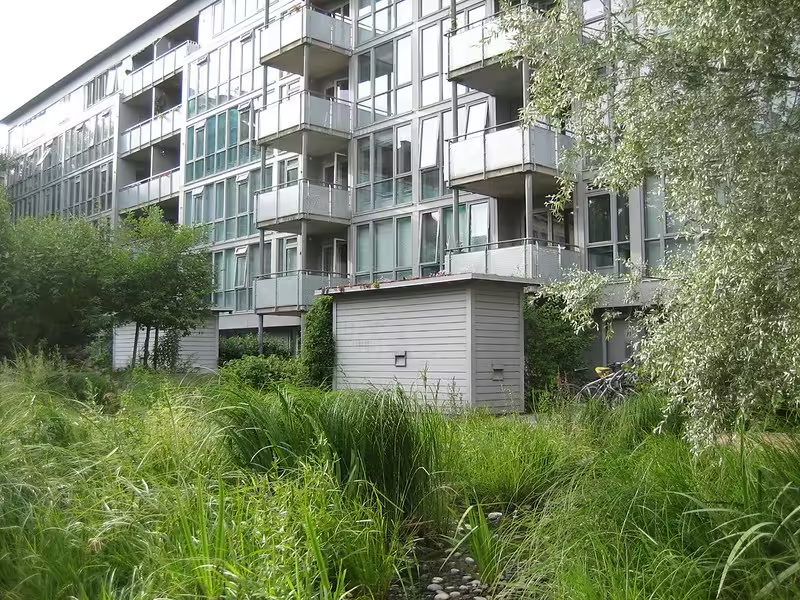
Putting your home’s greywater to work in your xeriscape is an excellent way to maximize water efficiency. Wetland biofilters are definitely worth checking out if you’re keen on greywater recycling:
- Sources of Greywater:
- Laundry machines
- Bathroom sinks
- Showers
- Greywater System Components:
- Collection pipes
- Filtration system (to remove debris and soap residues)
- Distribution system (often a branched drain field)
- Plant Selection for Greywater: Choose plants that thrive in the slightly alkaline nature of greywater, such as fruit trees, ornamental shrubs, and some native species.
Remember: Always check local regulations regarding greywater use in landscaping.
Efficient Irrigation Methods
Even in a xeriscape, some irrigation may be necessary. Here are some water-efficient techniques:
- Drip Irrigation:
- Delivers water directly to plant roots
- Reduces evaporation by up to 60% compared to sprinklers
- Can be connected to rainwater harvesting systems
- Soaker Hoses:
- Ideal for rows of plants or garden beds
- Releases water slowly into the soil
- Smart Controllers:
- Adjust watering schedules based on weather conditions
- It can be powered by solar panels for off-grid use
- Ollas:
- Unglazed clay pots buried in the soil
- Slowly release water to surrounding plants
- Perfect for small garden areas or container plants
Mulching: A Water-Saving Superstar
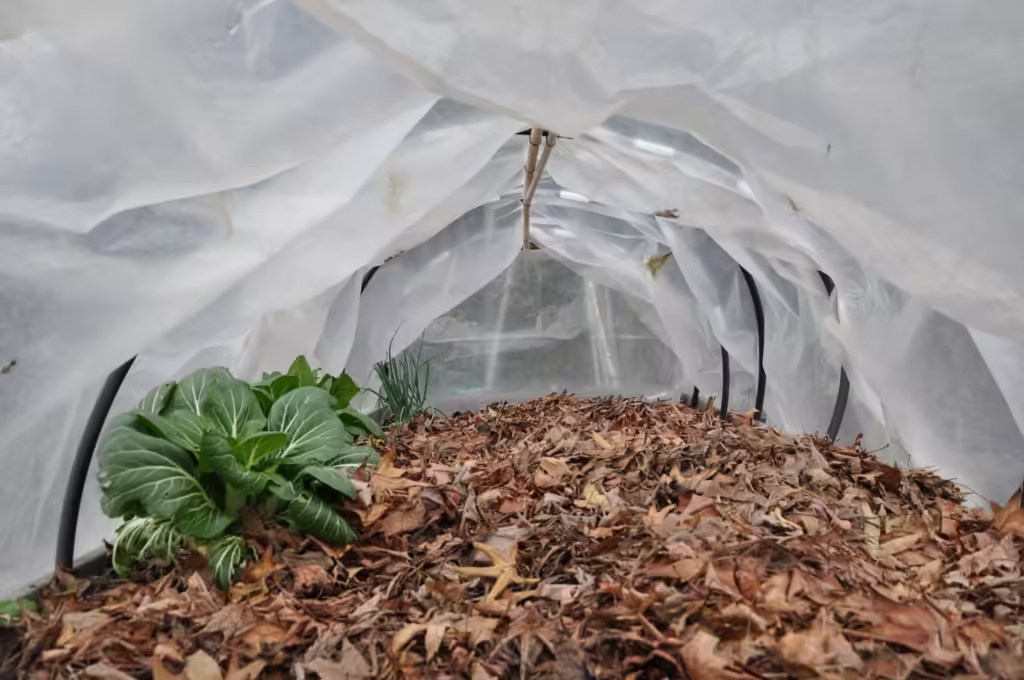
Mulch is a xeriscape’s best friend when it comes to water conservation:
- Benefits of Mulching:
- Reduces evaporation by up to 70%
- Suppresses weed growth
- Regulates soil temperature
- Improves soil structure over time
- Types of Mulch for Xeriscapes:
- Organic: Wood chips, straw, leaves, grass clippings
- Inorganic: Gravel, pebbles, crushed stone
- Application Tips:
- Apply a 2-4 inch layer around plants
- Keep mulch a few inches away from plant stems to prevent rot
- Replenish annually or as needed
Soil Improvement for Water Retention
Healthy, well-structured soil is crucial for water conservation in xeriscapes:
- Soil Testing: Conduct regular tests to understand your soil’s composition and needs.
- Organic Matter: Incorporate compost or well-rotted manure to improve water retention and soil structure.
- Cover Cropping: Plant cover crops in fallow areas to add organic matter and improve soil health.
- Avoiding Compaction: Use defined pathways and avoid working in wet soil to maintain good soil structure.
- Mycorrhizal Fungi: Consider adding these beneficial fungi to your soil to enhance water and nutrient uptake by plants.
By implementing these techniques your xeriscape will not only conserve water but also create a resilient, self-sustaining ecosystem. Start with the techniques that best suit your landscape, climate, and budget, incorporating any others the more you understand what your xeriscape needs. Remember that finding passive solutions is the best and saves you a lot of worry and time.
Choosing the Right Plants for Your Off-Grid Xeriscape
It’s been mentioned throughout so far that the importance of picking the appropriate plants is crucial for creating an efficient off-grid xeriscape. I have a habit of undermining this and encouraging a bit of experimenting to find what best suits what you want and/or need. However, it’s important to remember that the right choices not only conserve water but also help reduce maintenance, support local ecosystems, and potentially provide food for your home. These are some considerations and options you take and start with.
Native and Drought-Tolerant Plant Selection
Native plants are the backbone of any successful xeriscape, especially in an off-grid setting. These are the plants that have evolved to thrive in your local climate without you needing your blood, sweat, and tears to keep them alive.
Benefits of native plants:
- Adapted to local rainfall patterns
- Resistant to regional pests and diseases
- Support local wildlife and pollinators
- Often require less maintenance once established
To find the best native plants for your area:
- Consult local nurseries specializing in native plants
- Reach out to your county extension office for recommendations
- Observe naturally occurring plants in undisturbed areas near your property
Popular drought-tolerant plants for xeriscapes:
- Succulents (e.g., Sedum, Echeveria)
- Ornamental grasses (e.g., Blue Fescue, Feather Reed Grass)
- Mediterranean herbs (e.g., Lavender, Rosemary, Thyme)
- Native wildflowers (varies by region)
Pro Tip: Look for plants with silvery, fuzzy, or waxy leaves – these adaptations often indicate drought tolerance.
Edible Xeriscaping: Integrating Food Production
Who says a xeriscape can’t be productive? Most of the xeriscapes I have seen have unfortunately not integrated much food production into them besides shrubs and herbs like rooibos and rosemary, which are great in dry conditions and useful. However, incorporating edible fruits and vegetables would be a great goal for any off-grid xeriscape.
Drought-tolerant fruit trees:
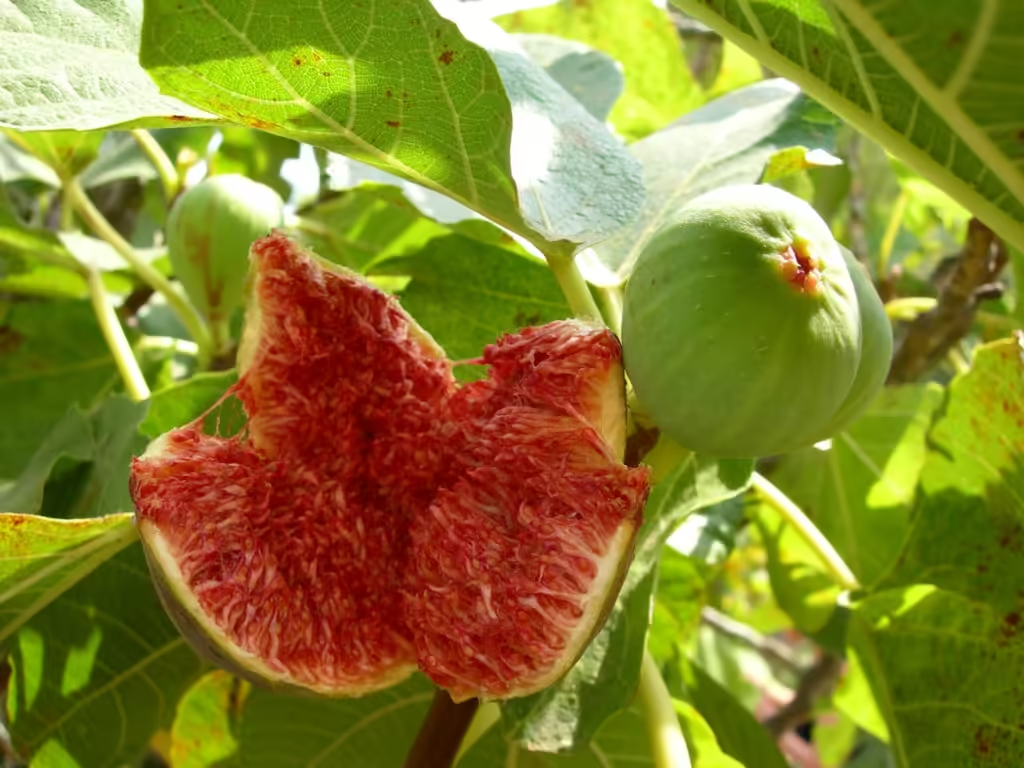
- Fig
- Pomegranate
- Olive
- Jujube
Water-wise vegetables:
- Artichokes
- Asparagus
- Bush beans
- Eggplant
- Peppers
Herbs for dry conditions:
- Sage
- Oregano
- Thyme
- Rosemary
When integrating edibles, consider creating small, intensively managed zones where you can concentrate your water and care efforts for maximum productivity.
Creating Biodiversity and Supporting Local Ecosystems
A diverse xeriscape is a resilient xeriscape. By including a variety of plant species, you’ll create a more balanced ecosystem that can better withstand pests, diseases, and environmental stresses.
Strategies for enhancing biodiversity:
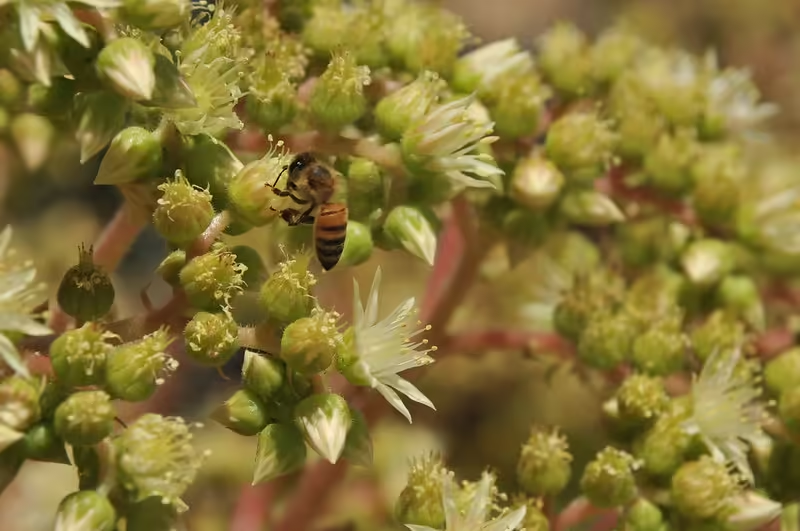
- Include plants of varying heights and structures
- Provide year-round food sources for wildlife (berries, seeds, nectar)
- Incorporate host plants for beneficial insects
- Create habitat features like rock piles or brush heaps
Key plant categories to include:
- Groundcovers (e.g., Creeping Thyme, Sedum)
- Shrubs (e.g., Butterfly Bush, Native Viburnum)
- Trees (e.g., Mesquite, Redbud)
- Perennial flowers (e.g., Coneflower, Black-Eyed Susan)
Remember: A diverse landscape not only looks beautiful but also requires less intervention to maintain ecological balance.
Low-Maintenance Plant Combinations for Year-round Interest
Creating plant combinations that look great together and share similar care requirements is key to a successful, low-maintenance xeriscape.
Tips for effective plant groupings:
- Combine plants with similar water needs (remember your hydrozone)
- Mix textures and forms for visual interest
- Include plants with different bloom times for year-round color
- Use evergreens or plants with interesting bark for winter appeal
Example of a low-maintenance plant combination:
- Tall backdrop: Ornamental grass (e.g., Little Bluestem)
- Mid-height filler: Drought-tolerant perennial (e.g., Russian Sage)
- Low-growing accent: Succulent (e.g., Hens and Chicks)
- Groundcover: Creeping Thyme or Sedum
Adapting to Microclimates in Your Landscape
Even within a single property, you may have various microclimates that affect plant growth. Identifying and working with these can help you choose the right plants for each spot.
Common microclimate factors:
- Sun exposure (full sun, partial shade, full shade)
- Wind patterns
- Soil type variations
- Proximity to structures (heat-reflecting walls, etc.)
By matching plants to these microclimates, you can create diverse plant communities and technically have multiple different xeriscape ecosystems that thrive with minimal intervention.
Establishing Your Xeriscape Plants
Once you’ve selected your plants, proper establishment is crucial for long-term success:
- Plant during the cooler seasons to reduce transplant shock
- Prepare planting holes twice as wide as the root ball
- Amend soil with compost if necessary
- Water deeply but infrequently to encourage deep-root growth
- Apply mulch to conserve moisture and suppress weeds
Remember, even drought-tolerant plants need regular watering during their first growing season to establish strong root systems but always watch them and adapt to what they need.
By carefully selecting and establishing the right plants for your off-grid xeriscape, you’ll create a beautiful, resilient landscape that thrives with minimal water and care.
Hardscaping Elements for Functional Off-Grid Xeriscapes
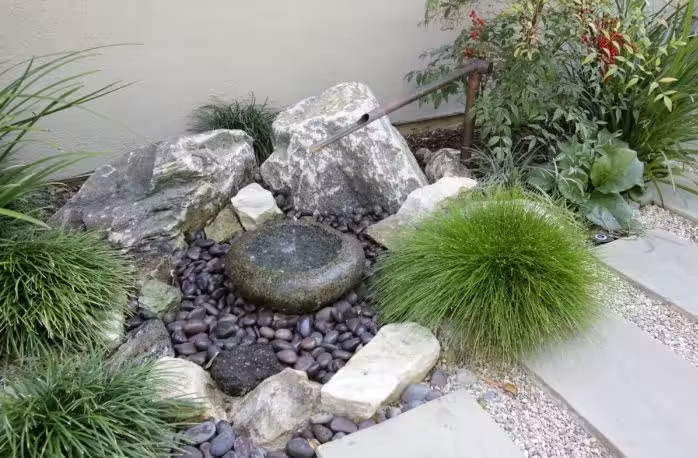
Hardscaping sounds bizarre but plays an important role in creating a functional and water-efficient off-grid xeriscape. These non-living elements add both structure and beauty to your landscape as well as water conservation and overall sustainability. These are some hardscaping components that can enhance your off-grid xeriscape.
Permeable Paving Options for Water Infiltration
Traditional impermeable surfaces like concrete can lead to water runoff and waste. Permeable paving allows water to seep into the ground, replenishing groundwater and reducing erosion.
Popular permeable paving options:
- Permeable Pavers
- Interlocking blocks with gaps for water drainage
- Can bear heavy loads, ideal for driveways and patios
- Gravel
- Inexpensive and easy to install
- Excellent for pathways and seating areas
- Porous Concrete
- Allows water to pass through its surface
- Suitable for walkways and light-traffic areas
- Grass Pavers
- Concrete or plastic grids filled with soil and grass
- Combines the benefits of turf and hardscaping
Installation Tip: Ensure proper base preparation with layers of gravel and sand for effective drainage.
Creating Shade Structures and Windbreaks

In an off-grid xeriscape, strategic placement of shade structures and windbreaks can significantly reduce water needs and create comfortable outdoor living spaces.
Shade Structure Ideas:
- Pergolas with drought-tolerant vines
- Shade sails made from UV-resistant fabric
- Natural shade from strategically placed trees
- Living walls with vertical succulent gardens
Windbreak Options:
- Dense hedgerows of native shrubs
- Decorative fencing with climbing plants
- Stone or earthen berms planted with grasses
Sustainable Tip: Use reclaimed or locally sourced materials for your structures to minimize environmental impact.
Incorporating Rocks and Gravel for Texture and Erosion Control
Rocks and gravel are xeriscape staples, offering both aesthetic and functional benefits:
Benefits of using rocks and gravel:
- Reduce soil erosion
- Conserve soil moisture
- Provide visual interest
- Require zero watering
Creative ways to use rocks and gravel:
- Dry Creek Beds
- Mimic natural waterways
- Direct water flow during rainy periods
- Rock Gardens
- Showcase drought-tolerant succulents and alpine plants
- Create microclimates for sensitive species
- Mandala Gardens
- Circular designs with concentric rings of rocks and plants
- Combine functionality with meditative aesthetics
- Gabion Walls
- Wire cages filled with rocks
- Can serve as retaining walls or decorative elements
Installation Tip: Use landscape fabric under gravel areas to prevent weed growth and soil mixing.
Building Raised Beds and Retaining Walls with Recycled Materials
Raised beds and retaining walls can help manage soil erosion, create level planting areas on slopes, and seperate different zones in your xeriscape.
Benefits of raised beds and retaining walls:
- Improve soil drainage
- Create microclimates for diverse plantings
- Increase accessibility for gardening
- Define and separate different landscape areas
Eco-friendly materials for construction:
- Reclaimed wood (ensure it’s untreated)
- Recycled concrete blocks
- Urbanite (broken concrete slabs)
- Repurposed metal panels
DIY Project Idea: Create a spiral herb garden using recycled bricks or stones, maximizing space and creating a beautiful focal point.
Water Features for Off-Grid Xeriscapes
While it may seem counterintuitive, small water features can actually benefit a xeriscape by:
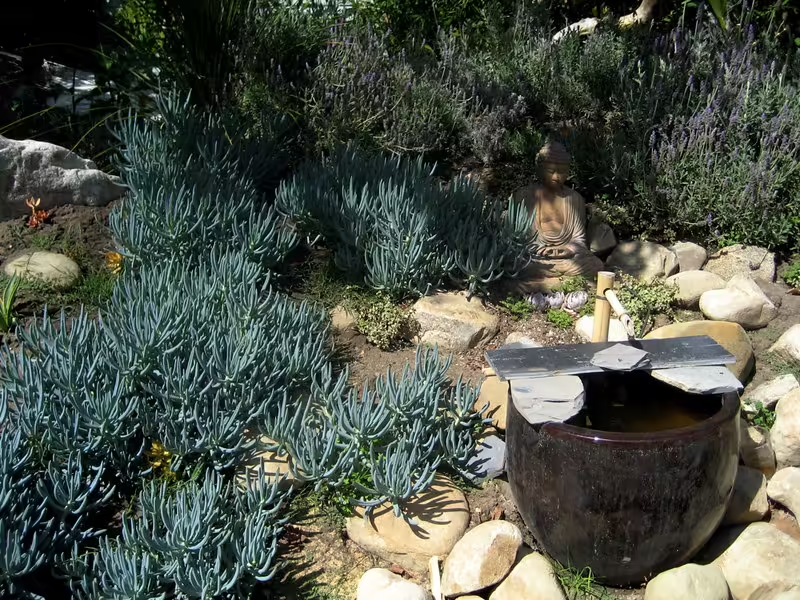
- Attracting beneficial wildlife
- Creating cooling microclimates
- Providing a focal point
Water-wise feature ideas:
- Solar-powered fountains
- Recirculate water to minimize consumption
- Provide soothing sounds and movement
- Wildlife-friendly ponds
- Use native aquatic plants for filtration
- Create shallow areas for birds and beneficial insects
- Pondless waterfalls
- Water disappears into a gravel bed and recirculates
- Minimal evaporation and maintenance
Installation Tip: Incorporate a rain sensor to shut off water features during rainfall, conserving water and energy.
Functional Outdoor Living Spaces
Extend your living area outdoors with hardscaped spaces that complement your off-grid lifestyle:
Ideas for outdoor living areas:
- Outdoor kitchens with water-efficient design
- Fire pits surrounded by drought-tolerant groundcovers
- Meditation or yoga platforms using permeable materials
- The rainwater collection features double as seating areas
Sustainability Tip: Use locally sourced or reclaimed materials to reduce transportation emissions and support the local economy.
Lighting for Off-Grid Xeriscapes
Lighting can extend the use of your outdoor spaces while maintaining energy efficiency:
Eco-friendly lighting options:
- Solar-powered path lights
- LED fixtures powered by off-grid energy systems
- Motion-sensor lights for security and energy conservation
- Low-voltage landscape lighting systems
Design Tip: Use downward-facing lights to reduce light pollution and protect nocturnal wildlife.
Incorporating some hardscape elements is a must in an off-grid xeriscape and will improve its functionality tenfold as well as its beauty
and sustainability. Remember to also strike a balance between hardscaping with softscaping (plants) to maintain the natural feel and ecological benefits of your xeriscape.
Maintaining Your Off-Grid Xeriscape: Tips for Long-Term Success
Creating a beautiful off-grid xeriscape is just the beginning. While xeriscapes are designed to be low-maintenance, they still require some care and attention, and if you get it right, your pride will have you in there all the time tinkering and dotting. Like with any garden, the fear that something will go wrong will also always be there, so here are some maintenance tasks you can use to keep your xeriscaping operating at its best.
Seasonal Maintenance Tasks for Xeriscape Gardens
Maintaining your xeriscape throughout the year helps prevent small issues from becoming big problems. Here’s a seasonal breakdown of key tasks:
Spring:
- Prune dead or damaged branches from trees and shrubs
- Remove winter mulch and reapply a fresh layer
- Check and repair irrigation systems
- Plant new xeriscape-friendly species
Summer:
- Monitor for signs of pest infestations or disease
- Deadhead flowers to encourage continuous blooming
- Adjust irrigation as needed during hot spells
- Remove weeds before they go to seed
Fall:
- Cut back perennials after they’ve finished blooming
- Plant spring-blooming bulbs
- Collect seeds from native plants for future propagation
- Prepare water features for winter
Winter:
- Protect sensitive plants from frost
- Prune deciduous trees and shrubs while dormant
- Clean and sharpen garden tools
- Plan for any landscape changes in the coming year
Pro Tip: Keep a garden journal to track maintenance tasks, plant performance, and weather patterns. This information will be invaluable for fine-tuning your xeriscape over time.
Organic Pest and Disease Management in Water-Wise Landscapes
A healthy xeriscape is naturally resistant to pests and diseases. However, occasional issues may arise. Here’s how to manage them organically:
- Prevention: Choose disease-resistant plant varieties
- Maintain proper plant spacing for air circulation
- Water at the base of plants to keep foliage dry
- Monitoring: Regularly inspect plants for signs of trouble
- Identify beneficial insects and encourage their presence
- Use yellow sticky traps to monitor insect populations
- Treatment: Remove affected plant parts promptly
- Use organic insecticidal soaps for soft-bodied pests
- Apply neem oil for fungal issues
- Introduce beneficial predatory insects like ladybugs or lacewings
- Cultural Practices: Rotate annual crops to break pest cycles
- Use companion planting to deter pests naturally
- Maintain healthy soil with regular addition of organic matter
Remember: A diverse xeriscape with native plants is more resilient to pests and diseases. Embrace some level of insect activity as part of a healthy ecosystem.
Pruning and Plant Care Techniques for Drought-Tolerant Species
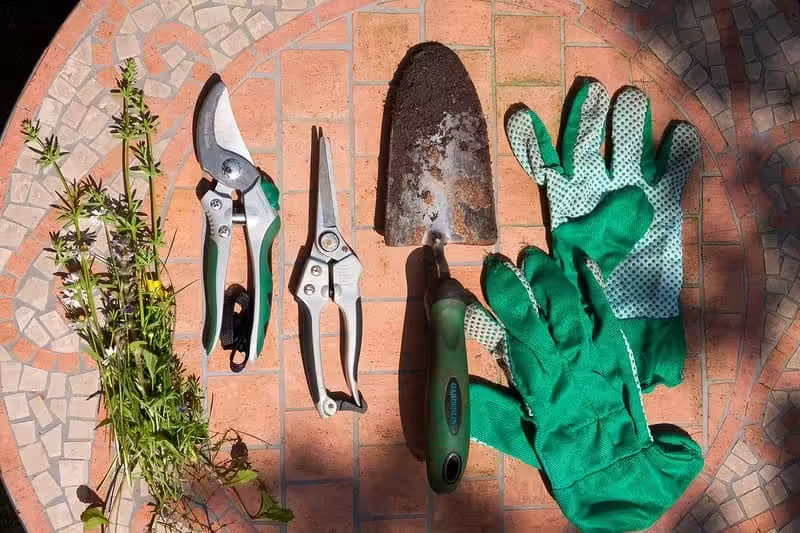
Proper pruning and care help maintain the health and appearance of your xeriscape plants:
General Pruning Tips:
- Prune during the plant’s dormant season or after flowering
- Use clean, sharp tools to prevent disease spread
- Remove dead, damaged, or crossing branches first
- Avoid over-pruning, which can stress plants
Specific Care for Drought-Tolerant Plants:
- Succulents:
- Remove dead leaves to prevent rot
- Prune to maintain shape and size
- Allow cuts to callous before watering
- Ornamental Grasses:
- Cut back deciduous grass in late winter/early spring
- Divide clumps every 3-4 years to maintain vigor
- Native Shrubs:
- Prune lightly to maintain natural form
- Avoid shearing, which can damage the plant’s structure
- Drought-Tolerant Trees:
- Focus on structural pruning when young
- Remove water sprouts and suckers regularly
Expert Advice: Learn the specific needs of each plant species in your xeriscape. Some drought-tolerant plants may actually suffer from too much pruning or care.
Soil Maintenance in Xeriscapes
Healthy soil is the foundation of a thriving xeriscape. Here’s how to maintain soil health:
-
- Mulching: Replenish organic mulch annually to a depth of 2-4 inches
- Keep mulch away from plant stems to prevent rot
- Use inorganic mulches like gravel in extremely dry areas
- Soil Testing: Conduct a soil test every 3-5 years
- Adjust soil pH and nutrients based on test results
- Composting: Add homemade or well-aged compost to improve soil structure
- Apply a thin layer of compost annually as a nutrient boost
- Avoiding Compaction: Use designated pathways to prevent soil compaction
- Aerate compacted areas gently with a garden fork
- Cover Cropping: Plant cover crops in bare areas to improve soil health
- Choose drought-tolerant varieties like clover or buckwheat
Soil Health Tip: Encourage beneficial soil microorganisms by avoiding chemical fertilizers and pesticides.
Efficient Irrigation Management
Even in a xeriscape, some irrigation may be necessary. Here’s how to manage it efficiently:
-
- Regular System Checks: Inspect for leaks, clogs, or damaged components monthly
- Clean filters and flush drip irrigation lines seasonally
- Watering Schedule Adjustments: Water deeply but infrequently to encourage deep-root growth
- Adjust watering times based on seasonal needs and rainfall
- Smart Technology Integration: Use soil moisture sensors to prevent overwatering
- Install rain sensors to automatically skip irrigation during rainfall
- Water Conservation Techniques: Capture and use rainwater for irrigation
- Reuse greywater when local regulations allow
Irrigation Wisdom: Water early in the morning to minimize evaporation and allow foliage to dry, reducing disease risk.
Monitoring and Adjusting Your Xeriscape Design Over Time
Your xeriscape is a living system that will evolve. Regular monitoring and adjustments ensure its continued success:
-
- Plant Performance Evaluation: Note which plants thrive and which struggle
- Replace underperforming plants with more suitable species
- Hardscape Maintenance: Repair any damage to pathways, walls, or other structures promptly
- Clean and reseal permeable paving as needed
- Wildlife Observation: Monitor the types of wildlife your xeriscape attracts
- Add features to support beneficial species if needed
- Water Use Assessment: Track your water usage over time
- Identify areas for further water conservation
- Aesthetic Adjustments: Thin out overcrowded areas to maintain plant health
- Add or relocate plants to improve visual appeal
Continuous Improvement: Be open to experimenting with new plants or techniques to enhance your xeriscape’s performance and beauty.
Following these maintenance tips and staying attuned to the changes and needs of your xeriscape will keep it thriving for years to come.
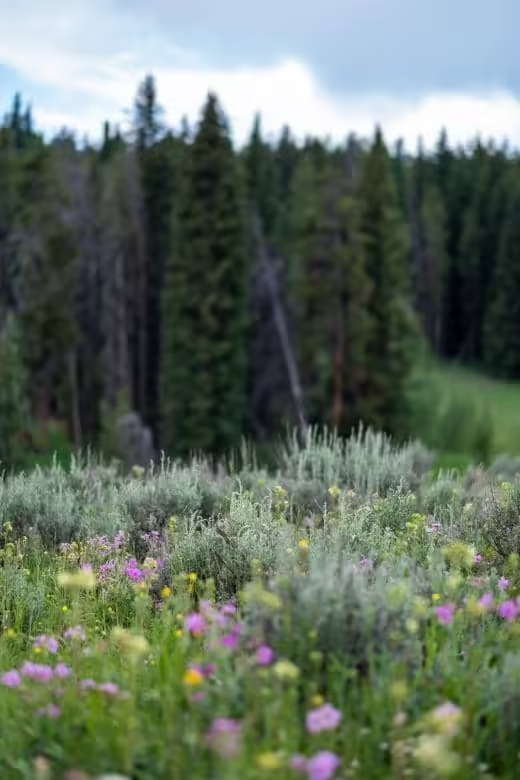
Xeriscaping off-grid is more than just a landscaping trend – it’s a sustainable solution for the future of self-sufficient living. By embracing water-wise techniques, choosing native plants, and designing with nature in mind, you can create a beautiful, low-maintenance landscape that thrives without relying on external resources. As we face increasing environmental challenges, your off-grid xeriscape will stand as a testament to the power of working with nature, not against it. Ready to transform your outdoor space? Start small, experiment, and watch as your sustainable oasis comes to life!
